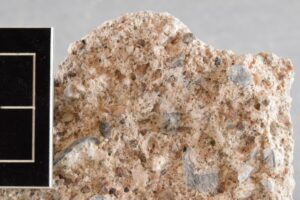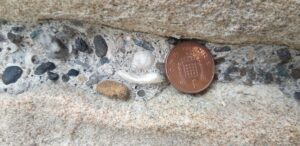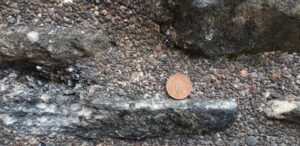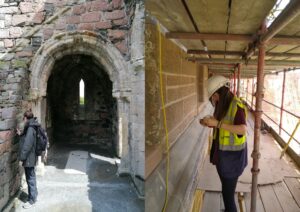What is mortar analysis?
Materials, Science | Written by: Mercedes Checa-Ros | Friday 9 February 2024
A good understanding of construction techniques and materials is vital for the conservation and maintenance of our historic buildings. To mark the United Nations International Day of Women and Girls in Science, Conservation Trainee Mercedes Checa-Ros details her important work analysing historic mortars at Historic Environment Scotland and Scottish Lime Centre Trust (SLCT), and what the traineeship involves.
Why is mortar analysis important?
Mortars hold together and separate individual stones in a wall, and they are made up of a binder (in historic mortars this is usually lime), an aggregate (such as sand) and sometimes other additives.

A lime mortar sample received at the Engine Shed laboratory where the different components within the binder are visible.
In building conservation, the use of lime mortars of various composition is also a recognised practice for renders, external finishes and joints. Knowing the behaviour of materials and their interaction with the environment and the context in which they have been used is important to make the correct conservation decisions.
This not only includes the knowledge of original building materials (their composition, characteristics, and their evolution over time) but also what repair materials would be appropriate. Using the wrong materials to repair historic buildings can cause damage.
Analysing the existing mortar before deciding on a new specification is important for any conservation project. This prevents damage to the stonework, ensures correct function of all the parts of the wall and helps to blend repairs into the existing building.
Not all commercially available limes are compatible with traditional Scottish lime mortars, and further research is needed to determine suitable materials and methods of manufacture for use in traditional Scottish buildings. This can be achieved by the documentation and analysis of historical lime mortars to understand their composition, properties, and behaviour over time.


Different types of mortar found in Blackness Castle. The different sizes, shapes and types of the aggregates that make up the different types of mortars are clearly visible. The presence of shells forming part of the aggregates is remarkable.
What is mortar analysis?
In order to respond to this need to better understand the fabric of historic buildings, we need to analyse lime mortars. The mortar analysis process aims to identify trends in the way lime was produced and used for specific functions in Scotland. This improves our understanding of historic building materials and assists in the proper repair of historic fabric through choice of raw materials and mix design.
To answer specific questions about the materials and determine their physical and chemical properties the method of analysis is as follows:

a) Visual analysis of the hand specimen. In this sample, you can see a large white lime inclusion to the right of the 2cm scale. b) The colour of the sample is compared to the Munsell Colour Chart and recorded. c) The pink staining after reaction with the phenolphthalein indicator shows areas where the sample is not carbonated.
- A visual hand specimen test is done to determine the colour, strength and hydraulicity (measure of water resistance) of the sample, plus the presence of shells, lime inclusions, and coal fragments. The mortar sample carbonation is also tested by reaction with phenolphthalein indicator.
- A further visual analysis through a microscope is used to study the binder texture, the aggregates, any inclusions, any alteration features, and the porosity of the sample. This is done by the droplet porosity test, which consists of placing small drops of water across different faces of the mortar. Notes are then made of any observations on the duration of water absorption, and movement across the surface.
- The sample then undergoes acid digestion with a weak solution of hydrochloric acid to dissolve the binder and keep only the aggregates. After filtration, this shows the amount of insoluble material, and the amount of dissolved binder is then calculated based on the weight before and after acid digestion.
- The aggregate is graded using a set of differently sized sieves. This is visually shown using an aggregate grading graph (below right).
- Using the aggregate grading, a suitable modern aggregate match is found. This is useful because the aggregate used greatly influences the colour and appearance of the final mortar.
- The results from the analysis then inform calculations estimating the probable original binder to aggregate ratio.

a) The chemical reaction of the sample after reaction a solution of 5% hydrochloric acid. b) The left-over aggregate after the acid digestion and grading. c) The aggregate is presented in a aggregate grading graph.
Other types of mortar analysis
This standard method of analysis can be complemented by other techniques, such as petrographic analysis. For this, the mortar is cut into a very thin layer and looked under a microscope to identify grain types and their arrangements. This provides information on the history of the mortars, such as the manufacturing process, origin of the material, hydraulicity, binder type and any additive.
X-ray diffraction is another test, which provides the mineralogical makeup of the mortar in order to know the different minerals that compose the sample and their proportion.

Some of the results of the analysis of lime mortar samples. a) X-ray diffraction results, showing the spikes of individual minerals. b) Microscopy image of a thin section of lime mortar.
Scotland’s mortars database
Through its Building Advisory Service, the Scottish Lime Centre Trust (SLCT) provides analysis and assessment of building materials to assist in repair specifications and for archaeological purposes, as well as to identify reasons for failure. Our funded partnership with them has created a ‘mortars database’ containing the details of over 4,000 mortar samples. It provides a unique and valuable historical record of the traditional materials used in the construction and repair of many of Scotland’s traditional buildings and structures.
Working together with the SLCT, one of the main tasks of the traineeship was to update this database and revise and re-analyse archived mortar samples.

The SLCT Mortars Database.
What are the benefits of site visits?
The traineeship also included various site visits made to take mortar and stone samples for laboratory analysis. By visiting the site, it is possible to understand the context of the sample and the link to where the materials might have come from.
These visits also give a wider appreciation of Scottish cultural heritage and the building materials involved, and they serve as a way to learn about the projects and studies that Historic Environment Scotland is developing. For example, one of these is the ‘harl as you go’ research project run in collaboration with Dr Tim Meek of the University of Stirling.
This study aims to review the connection between pointing and harling mortars, as it is thought that these would have been applied at the same time, using one mortar mix. In analysing different samples of historic Scottish mortar, the team are looking at how exposure to the weather over time affects the mortar and the building as a whole.

The author on different site visit locations, inspecting lime mortars.
To learn more about the International Day of Women and Girls in Science, visit the official website.
For more information about the SLCT mortars database and Scottish historic mortars, read our technical report on the analysis of the database.
To learn more about the ‘Harl as you go’ project, read our report on historic external lime finishes in Scotland.
About the author:
Mercedes Checa-Ros
Mercedes Checa-Ros was a Mortar Analysis Trainee, working in the Heritage Science Team at the Engine Shed. She graduated in Geology at the University of Granada (Spain) and her traineeship was based on the analysis of historic mortars, as well as on the collaboration with the Scottish Lime Centre Trust for the update of its mortar database. Mercedes has since moved on to an opportunity elsewhere.
View all posts by Mercedes Checa-Ros



